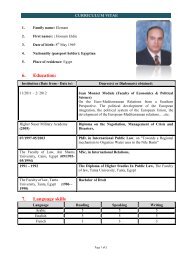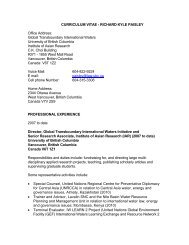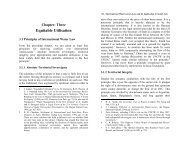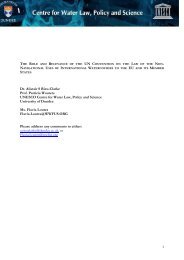Upreti, Trilochan, International Watercourses Law and Its Application ...
Upreti, Trilochan, International Watercourses Law and Its Application ...
Upreti, Trilochan, International Watercourses Law and Its Application ...
Create successful ePaper yourself
Turn your PDF publications into a flip-book with our unique Google optimized e-Paper software.
180 / <strong>International</strong> <strong>Watercourses</strong> <strong>Law</strong> <strong>and</strong> <strong>Its</strong> <strong>Application</strong> in South Asia Prospects <strong>and</strong> Problems of Nepalese Water Resources / 1814.1 IntroductionChapter- FourProspects <strong>and</strong> Problems ofNepalese Water ResourcesNepal is a l<strong>and</strong>locked country surrounded on the south, east <strong>and</strong>west by India <strong>and</strong> on the north side by Tibet (a region ofChina), <strong>and</strong> comprising an area of 147,181 square kilometres.The country has three broad ecological zones consisting of 43%mountains, 30% hills <strong>and</strong> 27% plains. 1 Her population is 25million, of whom 85% live in rural areas <strong>and</strong> 42% live belowthe extreme poverty line. The Nepalese economy is based onagriculture: about 90% of the people’s occupations depend onit, <strong>and</strong> agriculture is largely rain-fed, due to the rugged, harsh<strong>and</strong> steep hills; only one sixth of the total l<strong>and</strong> area is suitablefor cultivation, of which about 41% is irrigated. 2There are about 6000 rivers <strong>and</strong> rivulets in Nepal, having a totaldrainage area of 194,471 square kilometres, 45.7% of whichlies in Nepal. There are 33 rivers whose drainage area exceeds1000 sq km. Rivers in Nepal can be typically classified in threetypes depending on their discharge. The Kosi, G<strong>and</strong>aki, Karnali<strong>and</strong> Mahakali river systems originate in the Himalayas <strong>and</strong>carry snow-fed flows with significant discharge even in the dryseason. 3 The Mechi, Karnali, Kamala, Bagmati, West Rapti <strong>and</strong>1 S. N. Bastola, Water Resources Development of Mighty HimalayanRivers, Kathm<strong>and</strong>u: Sunil Bastola, 1994, p. 61.2 His Majesty's Government, Water <strong>and</strong> Energy Commission Secretariat,(HMG/N-WECS) Water Resources Strategy Nepal, Kathm<strong>and</strong>u,WECS, (2002), p. 14.3 Ministry of Water Resources, HMG/N (MOWR), Waters ResourcesDevelopment in Nepal, Kathm<strong>and</strong>u: 1985, p. 1.Babai rivers originate in the midl<strong>and</strong>s or Mahabharat range ofmountains <strong>and</strong> are fed by precipitation as well as by groundwater regeneration. These rivers are also perennial but arecharacterised by a wide seasonal fluctuation in discharge. Apartfrom these river systems, there are large numbers of smallrivers in the Terai, which originate from the Southern Siwalikrange of hills, <strong>and</strong> are seasonal with little flow during the dryseason, but are characterised by flash floods during themonsoon. Most of the rivers originate from the Himalayanrange within Nepal, while some originate from the TibetanPlateau; all these rivers drain southwards to the Ganges 4 inNorthern India <strong>and</strong> ultimately into the Bay of Bengal. TheMechi <strong>and</strong> Mahakali rivers form the eastern <strong>and</strong> westernboundaries with India <strong>and</strong> the other rivers flow to India, beingtransboundary in nature. The total average annual runoff intoNepal's rivers is estimated to be 200,000 million cubic metresoriginating from areas within the country; the catchment areasfrom Nepal alone make up about 45% of the long-term averageannual flow of the Ganges basin <strong>and</strong> contribute over 70% of theGanges flow during the driest months. 5With regard to climate, Nepal lies just beyond the northernlimit of the tropic. There is a very wide range of climate, fromthe summer tropical heat <strong>and</strong> humidity of the Terai to the colderdry continental climate in the middle, <strong>and</strong> the alpine winterclimate throughout the northern mountainous region. Theamount of precipitation <strong>and</strong> the temperature range varyconsiderably because of the exceptionally rugged terrain, <strong>and</strong>large variations in altitude. 6 Nepal has two rainy seasons: onefrom June to September when the south-west monsoon bringsabout 80% of the total annual rainfall, <strong>and</strong> the other in winter,accounting for the rest of the rainfall. About 64% of the rainfall4 P. Shumsher J. B .Rana, “Nepal-India Relations: Water Resources” inL. R. Baral (ed), Looking to the Future: Indo-Nepal Relations inPerspective, New Delhi: Anamol Pub., 1996, pp. 206-212.5 Ibid.6 Supra note 2.












